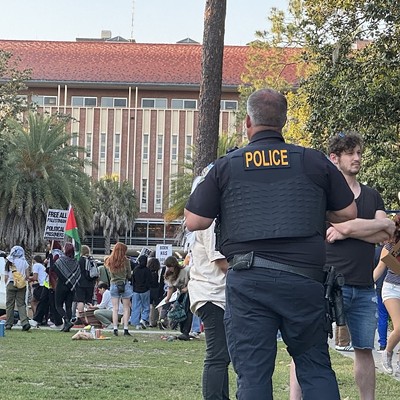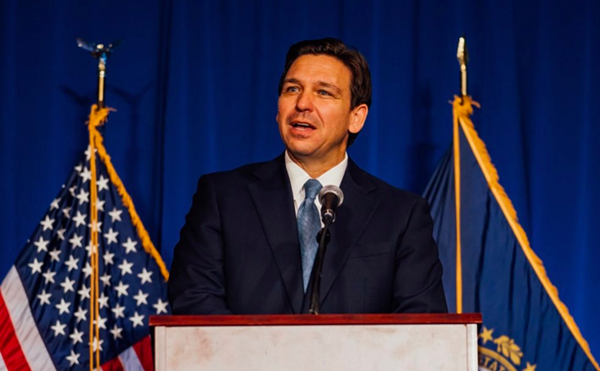Each weekday for the past three-and-a-half years, Sage Morris-Webster has ridden the bus from a parking lot at the T.D. Waterhouse Centre to her job at the Orange County Courthouse.
Each weekday, she encounters a handful of kids, toting knapsacks and lunch pails, riding the bus along with her and away from their Parramore homes. "It's so sad to know these kids have to leave their neighborhood to go to school," she says.
So she decided to do something to help them. A prosecutor in the State's Attorneys Office, Morris-Webster joined the board of an elementary charter school proposed for the downtown Parramore neighborhood -- Orlando's poorest and most crime-ridden -- which she hopes will soon begin teaching some of those kids. Board members of the charter school hope to open their doors to 126 kindergarten, first and second graders as soon as August, adding third grade in 2001 and fourth grade in 2002.
That August deadline, however, is not the school's only obstacle.
Some Parramore residents are opposed to the charter school, the first of its kind in Orlando to receive backing from city government. They have argued at Orlando City Council and Orange County School Board meetings that the school, as designed, is not what Parramore needs or asked for. They say the school, which is planned to be built adjacent to the city-owned Downtown Recreation Complex at Livingston and Parramore streets, is not centrally located in the neighborhood. They are concerned it won't have a playground with grass, trees, monkey bars and swings. They worry that the school will be unsafe. And they want a promise that Parramore children will be admitted first, before children living outside the neighborhood.
"If it's not guaranteed that children who live in this area can go to the school then don't build it over here," says Sharon Green, whose little boy attends a Parramore day-care center. "Put it somewhere else."
Chief among criticisms is that the city is rushing to charter the school, that plans for it were changed without residents' involvement, and that its backers claim to have a community consensus when they don't. Worse, the whole concept asks Parramore residents to trust the city's good intentions, when those same residents have heard such promises before, only to be burdened with poor delivery of services, especially police protection.
"Where in the United States would there be more valuable property than in Parramore, if only the city would enforce the laws and codes?" asks Phil Cowherd, 53, who owns rental property in the neighborhood. "The community would be integrated and the school district would want to put a school down here if the city would only enforce the law."
One Parramore parent said the neighborhood is so dangerous, she'd rather her children attend a school elsewhere -- Parramore children currently are bused to one of eight schools each day -- if only to escape the bleak Parramore landscape for a while. "The way I see it, I don't want my kids going to school over here," says Evelyn White, who has two children, ages 6 years and 21 months. "There's all kinds of crackheads and little stupid stuff going on. There's drunks who'll try speaking to you and get mad and want to call you names."
Though it has experienced several delays, the school is now just days away from being fully chartered. The Orange County School Board will vote Tuesday whether to approve the school's application; the City Council, which has budgeted $2.5 million to inaugurate the school, will vote May 8 on final approval of the project. After the school is up and running, the city's role will be as landlord of the building housing the students.
Among those who hope to divert the project is Lawanna Gelzer, an accountant for Greater Orlando Area Legal Services who co-owns the day care where Sharon Green's boy goes after school. Gelzer has been a sharped-tongued critic of the planned charter school, saying it wasn't what the community asked for when it began the project.
"Give us a school we can use," Gelzer says. "Give us the real thing. Give us what we need and deserve."
Her message to civic leaders is to forget the $261,000 they've already spent on design of the charter school and begin looking for ways to fund a school that doesn't have a "flawed application."
"Come back to the community and listen," says Gelzer, who ran unsuccessfully for city council last year. "Hear the whole picture ... . The facts support not awarding a charter."
Gelzer has no quarrel with Morris-Webster or the other 11 members of the charter school board, most of whom began working as a group several months ago. "I'm not picking on these people," Gelzer says. "I'm not questioning their integrity."
Rather, she and others pointedly question the role of the Parramore Heritage Renovation Foundation, a six-year-old nonprofit corporation that has had a troubled, if not ugly, past. The Foundation, which has done most of the legwork to charter the Parramore school, saw its funds dry up and its corporate status dissolved for most of 1998 and 1999. When it reincorporated in September, almost its entire board had been replaced.
Gelzer -- whose mother, Betty, sits on the Foundation board and agrees with her daughter's position on the school -- is one of several people who distrusts the Foundation as much as anarchists distrust the International Monetary Fund. They accuse the Foundation of being a puppet of the city, specifically Mayor Glenda Hood, because of the hundreds of thousands of dollars the city has budgeted for the corporation -- most of it straight out of the city's bank account. Hood also has appointed two city employees, her special assistant Walter Hawkins and Downtown Development Board director Tom Kohler, to serve as executives-on-loan to the Foundation.
As Gelzer and Cowherd see it, federal money earmarked for Parramore upgrades and redevelopment is funneled into the Foundation and then disappears without any accountability. The Foundation so far hasn't produced its required federal tax forms for public inspection, fanning speculation that the organization has mismanaged money. "Their past history shows an inability to do simple accounting practices," Gelzer says.
Gelzer also criticizes the Foundation's board members for failing to listen to residents when they compiled their charter-school application. Or, when they did listen, she says they got it wrong.
For example, the Foundation initially sent out 800 surveys to Parramore residents, seeking opinions about establishing a school within the area's boundaries. (City officials have long heralded a school as part of the neighborhood's salvation, in an if-you-build-it-they-will-come attempt to lure homeowners and bolster the area's depressed income levels.) None of the surveys were returned, Gelzer says. So, in an effort to help, she oversaw a group of neighborhood children who canvassed the streets of Parramore asking for signatures on a petition that sought support for a community school. But the signatures were never accepted by the Foundation. Where are they now?
"She has them," Lawanna says, pointing to her mother, Betty Gelzer.
Likewise, four community meetings were held to discuss locating a school in the Parramore area. During those meetings, architect Craig Stark, who sits on the Foundation, indicated that the group was considering four locations for a community school.
None of the locations, however, was the site that was eventually chosen. And at no point was a charter school mentioned to the public before it was unveiled as the final choice. When residents learned that the plan had changed, some weren't too happy.
"We were promised a steak," says David van Gelder, a Parramore resident, "but they delivered a bone."
Orange County Schools superintendent Dennis Smith told school board members on April 11 that there was nothing unusual about the charter thus far.
But there is something unusual about Parramore, the shame of Orlando, a community where dangers real and imagined lurk behind every corner, in every motivation, and especially when there's another government program involved.
Members of the Renovation Foundation are aware that they represent "old baggage," as Gerald Bell, a vice president with the organization, puts it. That's why the Foundation has turned the charter school over to a governing board whose members have impeccable credentials.
In addition to Morris-Webster, the board's members include chairwoman Rebekah McCloud, director of academic support services at the University of Central Florida; Circuit Judge Belvin Perry; Rebecca Ford, the widow of former city commissioner Nap Ford; and three members of the Parramore Heritage Renovation Foundation.
Stark and other members of the Foundation began pursuing the charter school idea after hearing that the school board likely would not build a school in Parramore within the next couple of years. A relatively recent addition to the local landscape, charter schools are a blend of the private and public sectors. They are independently financed and governed, yet are granted authority to operate by public school boards and made to adhere to public school standards. "If we would have waited for the school district to grant a school, I don't know if we would have gotten one at all," says Bell.
One of the advantages of charter schools, whose board members in this case must raise funds to pay their bills, is that they can teach in a sophisticated, nontraditional way. (The curriculum the new school hopes to implement has been prepared by a staff of educators from UCF, Orlando Regional Medical Center and CIBC National Bank, which is being called a "technology partner.") The Parramore Charter School intends to focus on a health and wellness curriculum that, for example, would teach first graders math by explaining their financial well-being through savings accounts and how to calculate interest. Students in science classes will learn about the Earth's elements by being taught how sunlight reacts with carbon dioxide to produce the greenhouse effect. Class sizes -- typically smaller in more tightly controlled charter-school settings -- are proposed to number 18 students, with eight classroom teachers on staff.
Operation of the school will be geared toward the community. Parents won't have to pay for their child to enroll but will be required to sign a contract saying they will participate in school projects. The school will stay open after-hours for adult and community classes, and families will be able to check out computers for home use.
City planners look at the school as a beginning. "There's probably room for other schools," says Kohler, of the Downtown Development Board. "This is an opportunity. This space was made available without our having to go out and buy land. This school doesn't preclude other sites from being built."
But the "many-school" idea isn't well received in Parramore, an area already divided by scattershot zoning and three neighborhood associations. "What do we need all these schools for?" asks Betty Gelzer. "We should want to help the neighborhood, to empower the neighborhood. That splits us up more."
The charter school plan still has discrepancies that must be ironed out. One is whether there will be a playground -- no small matter to many parents. "My son needs outside activities," says Green, the Parramore parent. "Kids his age need to experience insects and flowers."
McCloud, the board's chairwoman, says the school definitely will be developed with an outdoor playground. Yet plans submitted to the city's Permitting Department show none.
Another question, more heated, is which children will have the option to enroll. According to the proposal the charter school board sent to the Orange County School Board, the charter school will be open to students who "primarily reside" in the neighborhood, or to children of school employees. If demand runs beyond that, the school will resort to a lottery to decide who will and won't be admitted.
Pat Evans, the Foundation's executive director, told the City Council on April 17 the charter school hopes to negotiate with Orange County Schools for a percentage of its students to be drawn from Parramore.
Commissioner Bruce Gordy responded, "That's a different answer than I received several months ago from someone at the podium who was speaking with authority for the school."
The confusion was not lost on other council members. "We are getting information that is not whole," Commissioner Don Ammerman said. "We're getting information that could be interpreted in several different ways."
Some of the confusion between the opposing sides has spilled over into insults and innuendo.
David van Gelder is a 44-year-old Parramore resident who owns nine buildings on three acres on West Amelia Street within eyesight of the Waterhouse Centre, formerly Orlando Arena. He is concerned the location of the school should be more in the heart of Parramore, which will be more convenient for children walking to class, he says. Moreover, he has gathered 130 signatures on a petition requesting the school be better located and be expanded to enroll more kids.
On more than one occasion, van Gelder has been condemned for speaking out against the school.
Daisy Lynum, a city commissioner whose district includes Parramore, blamed van Gelder at a April 3 council meeting for orchestrating a plot to kill the charter school by blurring the issues. "Nobody has looked at some of Mr. van Gelder's issues because they haven't made a whole lot of sense," she said. "Does he want to sell his property? Does he want a night life in Parramore? What the heck does he want? And why are these people following him around like little ants or fleas or something? Why are they trying to destroy the community?"
A week later, van Gelder made a presentation to the Orange County School Board. When he was finished, he listened as school board member Katie Adams, an African American, challenged his arguments. "Every time I look, there's somebody complaining about what they don't want in Parramore," she said. "I don't hear the parents from Parramore complaining they don't want a school. I hear this man saying they don't want a school. How does he know what people in Parramore want? They didn't tell me. And I look like them. So why would they tell him?"
After both incidents, school board and city council members defended van Gelder, saying his arguments must be respected. "I don't think any of us can look at a taxpayer and ask what his motives are," school board member Barbara Trovillion-Rushing said, responding to Adams.
Van Gelder, meanwhile, says he hopes future constituents aren't treated as he was. "I don't have to be a parent to express my views," he says. "I don't have to be married. I don't have to be a resident of Parramore, which I am. I'm a property owner who pays $25,000 in taxes a year, a good percentage of which goes to public schools."
Another question is why the city wants so badly to develop the school as part of the existing Recreation Complex. City officials have said the building, whose north side will be renovated and expanded, was selected because the city had only $2.5 million to spend on the project -- nowhere near the amount needed to start from scratch. (The recreation center, formerly the training court for the Orlando Magic, will remain on the site.) According to the proposal that the charter school sent to the Orange County School Board, the city will collect rent of $15 per square foot on the property; van Gelder says commercial property in Parramore currently rents for $9 per square foot. Although the charter school board hopes for an August start-up, any new construction is not expected to completed until late October.
But Phil Cowherd discounts the city's view that the building was appealing because it was cheaper and immediately available. He suspects a more sneaky motive, and contends the site was chosen because the city's Community Redevelopment Agency wants to justify purchasing three acres of land it bought in the area several years ago.
The agency, which spent $500,000 for the land, intends to build a number of homes on Otey Street, following up Phase I of its Parramore revitalization plan that completed 39 subsidized homes on Conrad and Arlington streets at the north end of the neighborhood.
One of the potential obstacles to Phase II, however, is a liquor store on Parramore Street. 414 Liquors has been described as a hangout for hookers and drug dealers. During the day, men sit on stools inside the store staring numbly at a small television set in a corner; at almost any time, a number of people can be seen loitering in the parking lot.
With 414 Liquors in the area, prospective Phase II home buyers likely will shy away from Otey Street, Cowherd says. Thus, the city's placement of the charter school virtually across the street fosters resentment against the liquor store operators that could put them out of business, Cowherd says.
Indeed, the city already drove the Crossroads Mission from its location several doors down from the liquor store, he adds. The city chased the mission off in October by having the city-run Orlando Utilities Commission claim the mission was using stolen electricity by splicing wires at the electrical box. (Mavis Starke, its proprietor, says she was running an electric cord from one apartment to another. She also disputes reports that the mission was nearly $9,000 in debt to the OUC and owed $7,000 back rent.) The OUC slapped condemned stickers on the two-story building and evicted the 30 people living inside.
Three months later, about 40 law-enforcement agents raided 414 Liquors after its proprietors, Yong Han and Sak Soon Lee, allegedly bought contraband cigarettes from an undercover police officer.
Lawanna Gelzer says the two events are signs that the city "bullies" people when it wants to get its way.
"This is all about what planners think," Cowherd adds.
Whether the mayor's office in particular is orchestrating a covert sweep of what it deems to be undesireables is difficult to prove. The city has said publicly that it had nothing to do with closing the mission. Starke herself doesn't feel her mission was closed because of the school. She believes the city closed it because it wanted her property for arena parking and because she opposed light rail -- showing herself to be something of a conspiracy theorist.
Whatever the case, the building was recently sold to the Greater Orlando Neighborhoods Inc., a 14-month-old nonprofit organization, and the Parramore Heritage Renovation Foundation. They intend to turn the L-shaped building into low- to moderate-rent housing.
Julia C. Lemon, executive director of the Greater Orlando Neighborhoods, says there's no connection between her purchase of the building in March and the charter school's opening in August. "My mission is not the school," she says.
But she continues: "Anything that happens in Parramore is frequently seen by others as being related events when that's not necessarily valid. It's a human thing to try to make sense out of chaos. People are inclined to draw lines between two dots that might not be related causally. But there might exist a correlation between the two because they happen side-by-side."
In the coming weeks, Pat Evans, the Parramore Heritage Renovation Foundation's executive director, will meet individually and in a workshop with City Council members. They hope to iron out any misunderstandings surrounding the school.
Hopefully, someone from the group will emerge with a coherent plan that can be built into a consensus -- a leadership skill that seems to be lacking not just in Parramore but all of Orlando.
"Parramore is a special area where we need to find a starting point," Councilman Ammerman said at the council meeting Monday. But without vision and diplomacy, that starting point becomes just another dot on a very confusing map.


















